Introduction: Context and Relevance
The magnitude of overlapping and interlinked conflicts in West Asia, Northern, and Eastern Africa makes 2024 one of the most volatile years in the global political landscape, affecting the lives and livelihoods of millions and jeopardising peace and stability in the region and beyond.[1] In West Asia, the escalation of the longstanding conflict between Israel and Palestine (involving Hamas and Palestinian Jihadi groups) stands as a flashpoint of regional instability, exacerbating tensions across the Arab world and drawing external (state and non-state) actors into the conflict.[2] A case in point is the Iran-Israel strike and counterstrike[3], Israel-Lebanon’s periodic targeted attacks and counterattacks, the Syrian civil war[4], Yemen’s conflict[5], Libya’s unstable political landscape[6], Egypt’s insurgency[7], Sudan’s civil strife[8], Ethiopia’s ethnic tensions[9], Somalia’s Al-Shabaab insurgency[10], and Mozambique’s insurgency in Cabo Delgado[11]—all of which highlight the proxy nature of regional rivalries with both localised and transregional ramifications. These complex and interconnected conflicts in the wider Western Indian Ocean (WIO) region undermine governance and security structures, intensify humanitarian crises, and manifest threats such as transnational terrorism, organised crime, and illicit trade in narcotics and trafficking. The ongoing land-based conflict has a spillover effect on the WIO maritime domain, affecting maritime trade, energy supplies, and regional security. They undermine the security of vital global maritime trade routes passing through the region.
For India, this persistent instability underscores the need for strategic balancing to protect its economic and geopolitical interests in the extended maritime neighbourhood.[12] The WIO is critical to India’s strategic posturing, with its prosperity intrinsically tied to energy and trade transiting through this region. In navigating this volatile region—often described as an "arc of instability"[13]—New Delhi must tread cautiously in its engagement with states marked by conflict and fragility. Therefore, maintaining a balance between “strategic autonomy” and traditional policy of non-alignment remains critical. Such a balanced approach provides India with ample agency to strike the right chords to preserve its tag as a preferred security partner[14] and benevolent power[15],[16] in the region and beyond. As tensions rise, New Delhi’s ability to adapt and recalibrate its strategies will be pivotal in addressing the multitude of challenges the region forecasts.
India’s Arc of (In)Stability: Strategic Stakes and Key Security Concerns
The concept of the "Arc of Instability" was first introduced by Professor Paul Dibb in 1999 to describe the Pacific island chain in the context of Australian security.[17] Over time, this concept has been adapted by various scholars and strategists to different geographical and geopolitical contexts. For this write-up, the concept is expanded to include India’s primary areas of national interest,[18] specifically the Western Indian Ocean, which spans the Persian Gulf, the Arabian Peninsula, the Red Sea, and the East African coast. This expansion is guided by considerations such as energy imports, the Indian diaspora, overseas investments, geopolitical imperatives, and maritime security dynamics.
The region, marked by historical fault lines that fuel territorial and other disputes, forms a hypothetical geographical curve referred to as the “arc of instability and conflict.” Political instability, weak governance, ethnic and sectarian tensions, demographic pressures, and uneven economic growth create a volatile landscape manifesting instability and conflict. This instability fosters an environment ripe for exploitation by non-state actors and transnational crime networks, which capitalise on the region’s fragility spilling over land-based hostility and violent conflict into the maritime domain, posing direct threats to security and stability in the region and beyond.[19],[20] Extreme poverty further exacerbates these threats, particularly in the form of piracy and terrorism.[21] The presence of weak and fragile states, coupled with the influence of violent non-state actors, intensifies the manifestation of non-traditional security threats, undermining stability and compounding the region’s challenges.[22]
Fig 1: The Arc of Instability and India’s Primary Area of Interest
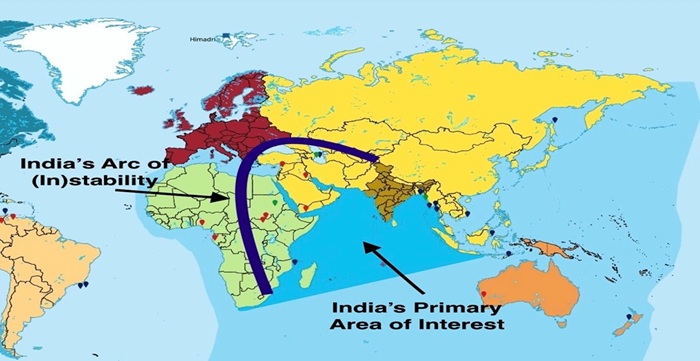
Source: Author’s Adaptation from IMSS-2015[23]
India’s Strategic Stakes
India's energy security, robust diasporic linkages, and significant trade and investment in West Asia and Africa are integral to its economic growth and prosperity. However, these gains are vulnerable to a fragile security environment and geopolitical volatility, which necessitate a comprehensive strategic approach. The maritime sector plays a pivotal role in facilitating 95% of India’s trade volume and accounting for 70% of its trade value, leveraging the country’s geostrategic position in the Indian Ocean.[24] Over the past decade, India’s dependence on maritime routes for energy imports has grown substantially, with over 40% of crude oil and 70% of natural gas supplies transiting through the Western Indian Ocean (WIO) region.[25]
Fig.2: Daily transit volumes of petroleum and other liquids through world maritime oil chokepoints (million barrels per day) (2023)[26]
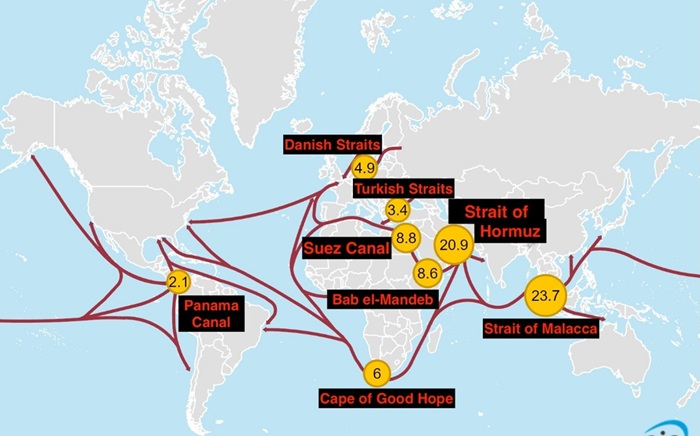
Fig. 2 adapted from https://www.eia.gov/international/content/analysis/special
India’s diaspora is also a crucial economic asset, particularly the 8.7 million[27] and the 3 million[28]–strong Indian diaspora in West Asia and Africa respectively is a great asset, who contribute over $30 billion[29] annually in remittances. The WIO region also serves as the pivot for India’s overseas trade and investment, with more than $215.83 billion[30] and $75 billion[31] in cumulative bilateral trade with West Asia and Africa respectively in 2021-22, spanning sectors such as energy, mining, infrastructure, and manufacturing. In Africa, India is well-positioned to increase its Foreign Direct Investment (FDI) to $150 billion by 2030,[32] underscoring the region's economic potential. Whereas in West Asia, India’s strategic partnerships reflect New Delhi’s expanding footprint, driven by collaborations in infrastructure projects and economic partnerships, such as the Comprehensive Economic Partnership Agreement (CEPA) with the UAE.[33] These deepening economic ties with both West Asia and Africa reinforce their strategic importance for India, necessitating a stable security environment to safeguard its economic and geopolitical interests. Geopolitically and geoeconomically, India’s transactional relations with key West Asian and African states have transitioned into robust strategic partnerships amidst India’s "Link and Act West Policy".[34] These efforts aim to cement India’s position as the preferred partner in its extended maritime neighbourhood. Several regional, sub-regional and bilateral constructs, such as I2U2 (India, UAE, USA, and Israel),[35] the India-Middle East-Europe Economic Corridor (IMEEC)[36], India and Southern African Customs Union (SACU) Preferential Trade Agreement (PTA),[37] India and Mauritius signed the Comprehensive Economic Cooperation and Partnership Agreement (CECPA),[38] India-GCC FTA,[39] India-Israel FTA[40], and the Indian Ocean Naval Symposium (IONS),[41] among others provide a structured framework to counter instability and enhance economic and security cooperation in this key region working toward the creation of an “arc of stability and opportunity”.
Key Security Challenges
India’s strategic autonomy and national interests are being severely jeopardised by the metastasising conflicts across key maritime regions. These conflicts, driven by a complex interplay of piracy, terrorism, state fragility, and major external power rivalries, have far-reaching implications for India, particularly in the context of its territorial security, trade, and energy security. The geopolitical dynamics of West Asia, exacerbated by the ongoing war in Gaza,[42] have compounded risks for India both politically and from a security perspective. New Delhi’s balanced and pragmatic stance in the Israel-Palestine dispute limits its room for diplomatic manoeuvring.[43] The Israeli airstrikes targeting Hamas’s leadership[44] and the escalating tensions between Iran and Israel,[45] and Israel’s invasion of southern Lebanon[46] attacking Hezbollah targets made the geopolitical environment more precarious, igniting the risk of a wider regional war, testing the resilience of India-Iran/Israel/Palestine relations. Moreover, in Syria, the abrupt abdication of dictator Bashar al-Assad[47] following a rapid 10-day offensive by opposition forces has further destabilised the region. The situation in Northern and Eastern Africa too, is not comforting either, as the region is witnessing growing turbulence, particularly in Libya, Sudan, Ethiopia, Somalia and Mozambique.[48] Such developments undermine regional stability with direct implications for the security of vital sea lanes, including the Bab al-Mandab Strait and Strait of Hormuz—a geographical chokepoint—critical for India’s trade and energy security. The ripple effects of these conflicts are not confined to West Asia and Africa but threaten the freedom of navigation to the high seas. During the Gaza and Lebanon wars, critical maritime routes have come under threat. The Houthis, for instance, have turned the Bab al-Mandab chokepoint into an anti-access/area-denial zone.[49] Since November 2023, they have launched over one hundred attacks on both commercial and military vessels.[50] These attacks have drastically reduced transit traffic (as normally more than 8.8 million barrels per day of oil and oil products pass through the Suez Canal daily)[51] with the number of transits plummeting by over 50 percent—from 2,068 in November 2023 to just 877 in October 2024 shows the gravity of the situation.[52] Shipping disruptions have driven freight rates to unprecedented highs,[53] as vessels are forced to reroute around the southern tip of Africa, to escape drone and missile attacks by Yemeni Houthis, further straining global supply chains that have pushed up oil and essential commodities prices.[54] Therefore, the emergence of new non-state and state-sponsored actors in WIO has exacerbated the situation, blurring the lines between traditional and non-traditional security challenges.
Fig 3 &4: Houthi Attacks in the Red Sea and Gulf of Aden[55],[56]
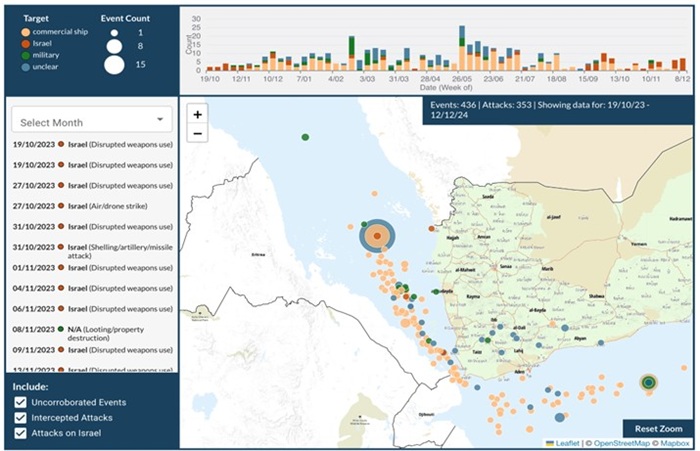
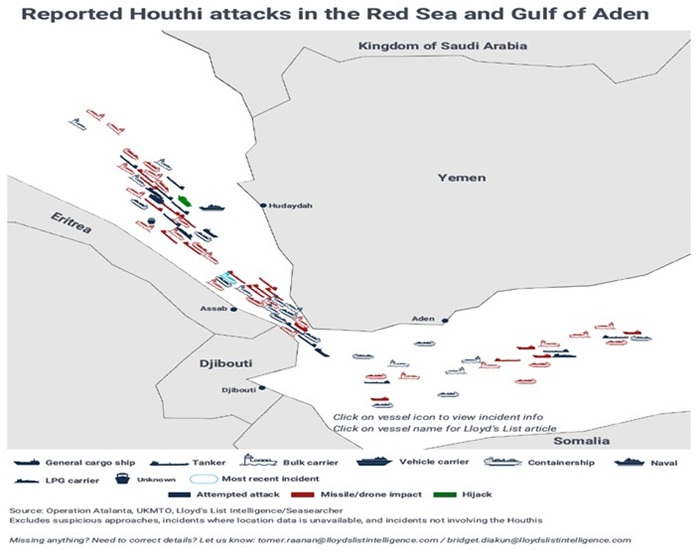
For India, these escalating threats underscore the vulnerability of its core national interests[57]—energy security, trade, and maritime access, along with the country’s diplomatic posture. Therefore, New Delhi’s deep historical and transactional ties with several nation-states of WIO, embroiled in conflict, force it into a serious policy dilemma: to either adhere to its traditional non-aligned stance or adopt a realist approach by addressing issues on a case-by-case basis, prioritising national interest. This duality underscores the challenge of balancing pragmatism with strategic autonomy in an increasingly multipolar and volatile global and regional order.
India’s Strategic Balancing: Strategic Autonomy and Pragmatic Engagement
India, the fifth-largest economy[58] and the world's largest democracy[59], with immense demographic potential[60], is rapidly emerging as a major power, aspiring to reclaim its historical prominence. However, much of this transition to global power depends on how effectively it balances its foreign policy in an increasingly polarised world undergoing sweeping changes. Guided by its core national interests and security objectives, New Delhi is adopting a multipronged strategy to navigate its turbulent extended neighbourhood while maintaining a fair degree of autonomy in its diplomatic, economic, security, and military engagements with the rest of the world.
India’s foreign policy reflects a nuanced and pragmatic approach to maintaining strategic autonomy amidst ongoing conflict. In West Asia, India has skilfully balanced relationships with regional rivals. For instance, it continues to engage with Iran[61] on key projects like the Chabahar Port despite U.S. sanctions, while simultaneously deepening ties with Saudi Arabia in energy, counterterrorism, and investment.[62] Its calibrated stance on the Israel-Palestine issue—advocating a two-state solution while expanding defence and technology ties with Israel—underscores this balancing act.[63] Beyond West Asia, India’s strategic autonomy is evident in its handling of global crises. During the Russia-Ukraine war, India abstained from anti-Russia UN votes, citing national interests,[64] while continuing imports of crude oil at discounted prices from Russia and providing humanitarian aid to Ukraine. With China, India balances its relations by combining strong responses to border tensions with continued engagement in multilateral forums like Brazil, Russia, India, China, and South Africa (BRICS) and Shanghai Cooperation Organisation (SCO). For the Littoral and Island States of the region, India remains the preferred security partner and first responder to crises offering assistance without interference to their domestic politics. These examples demonstrate India’s commitment to “multi-alignment”[65], balancing competing interests, and prioritising national objectives while contributing to regional peace and stability.
In this context, India is making a decisive departure from its historically non-aligned posture, embracing a more pragmatic, interest-driven approach that prioritises sovereign considerations, security objectives, and self-reliance. This evolving stance allows New Delhi to insulate its decision-making processes from external pressures and the ideological constraints often imposed by the Global North. Issue-based convergence has become the new norm in India’s bilateral engagements, reflecting a nuanced acceptance of the reality that national interests and partnerships are dynamic and must evolve to meet the demands of a rapidly changing world. As External Affairs Minister S. Jaishankar aptly summarised: “This is a time for us to engage America, manage China, cultivate Europe, reassure Russia, bring Japan into play, draw neighbours in, extend the neighbourhood, and expand traditional constituencies of support — all while continuing to reform economically and grow faster in a democratic system that is witnessing an increasingly vivid expression of its native beliefs and traditions”.[66]
Conclusion
Geographical determinism suggests that geography is vital to understanding power, strategy, and defence planning. The Indian government consistently identifies the WIO region as a critical area from which security threats to India’s well-being could most easily arise. As the then President of India, Shri Pranab Mukherjee, stated: “A nation’s social and economic well-being is intricately linked to the seas, not only for trade but also for how it faces threats to its security that develop across the seas... Our resolve to achieve high growth can be realised only if our maritime frontiers and assets are safe, stable, and act as enablers.”[67] Against this backdrop, India’s strategic balancing in the wider WIO reflects its commitment to safeguarding core national interests amidst an arc of instability marked by a region plagued by geopolitical tensions, fragmentation, fragility, security threats, and economic vulnerabilities. As India's economic, military, and technological capabilities expand, along with its global interactions and strategic stakes in the region and beyond, securing this ‘sphere of interest’ is paramount, as the WIO maritime domain remains a key enabler of its global resurgence. By pursuing strategic autonomy and pragmatic engagement, New Delhi seeks to navigate this complex landscape while securing vital energy supplies, trade routes, and maritime security. Anchored by principles of SAGAR (Security And Growth for All in the Region) the mission-based naval deployments, capacity-building initiatives, and diplomatic outreach, underscore India’s approach towards the region critical to its global aspirations.[68] Therefore, a comprehensive, integrated grand strategy remains essential for ensuring stability in the WIO, reinforcing India’s role as a responsible stakeholder in regional and global security.
References
[1] "Today's Armed Conflicts," at https://geneva-academy.ch/galleries/today-s-armed-conflicts (Accessed February 5, 2025).
[2] Leila Ouhri, Kate Springs, and Yaseen Rashed, "2024: A Year in the Middle East," Atlantic Council, December 19, 2024, accessed February 5, 2025, https://www.atlanticcouncil.org/blogs/menasource/2024-a-year-in-the-middle-east/.
[3] Raffi Berg, "Why Has Israel Attacked Iran?" BBC News, October 26, 2024, accessed February 5, 2025, https://www.bbc.com/news/world-middle-east-68811276.
[4] CFR.org Editors, "Syria’s Civil War: The Descent Into Horror," Council on Foreign Relations, December 20, 2024, accessed February 5, 2025, https://www.cfr.org/article/syrias-civil-war.
[5] Center for Preventive Action, "Conflict in Yemen and the Red Sea," Council on Foreign Relations, updated October 8, 2024, accessed February 5, 2025, https://www.cfr.org/global-conflict-tracker/conflict/war-yemen.
[6] “Libya’s Instability Has ‘Quite Rapidly’ Deteriorated and Will Worsen if No Elections, Says U.N. Envoy," The Hindu, August 21, 2024, 1:12 p.m. IST, accessed February 5, 2025, https://www.thehindu.com/news/international/libyas-instability-has-quite-rapidly-deteriorated-and-will-worsen-if-no-elections-says-un-envoy/article68549189.ece.
[7] "FCDO Advises Against All Travel to Parts of Egypt," UK Government Foreign Travel Advice, accessed February 5, 2025, https://www.gov.uk/foreign-travel-advice/egypt/regional-risks.
[8] "Sudan Conflict: ‘There Cannot Be a Military Solution to This War’," UN News, December 29, 2024, accessed February 5, 2025, https://news.un.org/en/story/2024/12/1158601.
[9] Liam Karr, "Africa File, September 26, 2024: Fano Offensive in Ethiopia’s Amhara; Egypt Arms Somalia; Rebel Drones in Mali; Burkina Thwarts Another Coup," Institute for the Study of War, September 26, 2024, accessed February 10, 2025, https://www.understandingwar.org/backgrounder/africa-file-september-26-2024-fano-offensive-ethiopia’s-amhara-egypt-arms-somalia-rebel.
[10] Center for Preventive Action, "Conflict With Al-Shabaab in Somalia," Council on Foreign Relations, last updated October 15, 2024, accessed February 13, 2025, https://www.cfr.org/global-conflict-tracker/conflict/al-shabab-somalia.
[11] Antonio Cascais, "Mozambique: Jihadists From Abroad Pour Into Cabo Delgado," Deutsche Welle, March 20, 2024, accessed February 9, 2025, https://www.dw.com/en/mozambique-jihadists-from-abroad-pour-into-cabo-delgado/a-68623366.
[12] Amb. (Retd.) Yogendra Kumar, "India's Policy Towards Its Extended Neighbourhood and the Larger Context of National Foreign Policy Challenges," May 13, 2016, accessed February 7, 2025, https://www.mea.gov.in/distinguished-lectures-detail.htm?524.
[13] "Militancy and the Arc of Instability in the Middle East and North Africa," Center for Strategic and International Studies, accessed February 6, 2025, https://www.csis.org/programs/former-programs/warfare-irregular-threats-and-terrorism-program-archives/militancy-and-1.
[14] "Indian Navy Over the Years Has Emerged as a Combat Ready, Credible and Cohesive Force, and Is the ‘Preferred Security Partner’ in the Indian Ocean Region: President Kovind," Press Information Bureau, Government of India, March 25, 2022, accessed February 12, 2025, https://pib.gov.in/PressReleaseIframePage.aspx?PRID=1809533.
[15] "Operation Dost: India’s Benevolent Humanitarian Assistance," IMPRI Insights, February 17, 2023, accessed February 5, 2025, https://www.impriindia.com/insights/india-turkiye-syria-humanitarian-assistance/.
[16] Tripti Nath, "India Is Accepted as a Benevolent and Benign Power: Anil Trigunayat," Awaz The Voice, August 7, 2023, accessed February 13, 2025, https://www.awazthevoice.in/world-news/india-is-accepted-as-a-benevolent-and-benign-power-anil-trigunayat-23140.html.
[17] "Securing Australia's Asia-Pacific Arc of Instability," Australian National University Programs and Courses, 2014, accessed February 11, 2025, https://programsandcourses.anu.edu.au/2014/course/stst2003.
[18] "Ensuring Secure Seas: Indian Maritime Security Strategy," Indian Navy, January 25, 2016, accessed February 8, 2025, https://bharatshakti.in/wp-content/uploads/2016/01/Indian_Maritime_Security_Strategy_Document_25Jan16.pdf.
[19] "Fragile States Index 2022 – Annual Report," Fund for Peace, July 13, 2022, accessed February 10, 2025, https://fragilestatesindex.org/2022/07/13/fragile-states-index-2022-annual-report/.
[20] "FY24 List of Fragile and Conflict-Affected Situations," World Bank, accessed February 9, 2025, https://thedocs.worldbank.org/en/doc/608a53dd83f21ef6712b5dfef050b00b-0090082023/original/FCSListFY24-final.pdf.
[21] "Poverty, Development, and Violent Extremism in Weak States," Brookings Institution, 2010, accessed February 12, 2025, https://www.brookings.edu/wp-content/uploads/2016/06/2010_confronting_poverty.pdf.
[22] Vanda Felbab-Brown, "Nonstate Armed Actors in 2024: The Middle East and Africa," Brookings Institution, January 16, 2024, accessed February 8, 2025, https://www.brookings.edu/articles/nonstate-armed-actors-in-2024-the-middle-east-and-africa/.
[23] "Ensuring Secure Seas: Indian Maritime Security Strategy," Indian Navy, January 25, 2016, accessed February 8, 2025, https://bharatshakti.in/wp-content/uploads/2016/01/Indian_Maritime_Security_Strategy_Document_25Jan16.pdf.
[24] "Text of Vice-President’s Address at the Inaugural Ceremony of the India Maritime Heritage Conclave (IMHC), New Delhi (Excerpts)," Press Information Bureau, December 11, 2024, accessed February 9, 2025, https://pib.gov.in/PressReleasePage.aspx?PRID=2083142.
[25] Amb (Retd) Anil Trigunayat, "West Asia and India – The Energy Dimension and Beyond," Organiser, January 26, 2023, accessed February 10, 2025, https://organiser.org/2023/01/26/106425/bharat/west-asia-and-india-the-energy-dimension-and-beyond/.
[26] U.S. Energy Information Administration (EIA), "World Oil Transit Chokepoints," June 25, 2024, accessed February 9, 2025, https://www.eia.gov/international/analysis/special-topics/World_Oil_Transit_Chokepoints.
[27] Raghav Aggarwal, "8.7 mn Indians Employed in West Asia, Mostly in Blue-Collar Jobs: Report," Business Standard, June 26, 2024, accessed February 10, 2025, https://www.business-standard.com/india-news/days-after-kuwait-tragedy-report-says-8-7-mn-indians-employed-in-west-asia-124062500977_1.html.
[28] Christine Mungai, "15 Facts About the Indian Diaspora in Africa," World Economic Forum, June 25, 2015, accessed February 8, 2025, https://www.weforum.org/stories/2015/06/15-facts-about-the-indian-diaspora-in-africa/.
[29] Kabir Taneja, "Did India Need to Stop Buying Oil from Iran?" Observer Research Foundation, February 27, 2023, accessed February 9, 2025, https://www.orfonline.org/expert-speak/did-india-need-to-stop-buying-oil-from-iran/.
[30] Ministry of Commerce & Industry, Government of India, "Foreign Trade (WANA)," Department of Commerce, accessed February 10, 2025, https://www.commerce.gov.in/about-us/divisions/foreign-trade-territorial-division/foreign-trade-wana/.
[31] Confederation of Indian Industry (CII), Pathways for Shared Progress: India-Africa Economic Cooperation, 19th Business Conclave, August 20–22, 2024, accessed February 11, 2025, https://www.cii.in/International_Resea.pdf.
[32] Ibid.
[33] Anil Trigunayat, The First India-GCC Foreign Ministers’ Strategic Dialogue – Outcomes and Assessment, Vivekananda International Foundation, September 20, 2024, accessed February 9, 2025, https://www.vifindia.org/2024/september/20/The-First-India-GCC-Foreign-Ministers-Strategic-Dialogue-Outcomes-and-Assessment. And Government of India, Ministry of Commerce & Industry, Comprehensive Economic Partnership Agreement Between the Government of the Republic of India and the Government of the United Arab Emirates (UAE), accessed February 12, 2025, https://www.commerce.gov.in/international-trade/trade-agreements/comprehensive-economic-partnership-agreement-between-the-government-of-the-republic-of-india-and-the-government-of-the-united-arab-emirates-uae/.
[34] Anil Trigunayat, India's Foreign Policy in West Asia, Distinguished Lecture at Indian Institute of Technology (IIT), Guwahati, March 29, 2019, accessed February 11, 2025, https://www.mea.gov.in/distinguished-lectures-detail.htm?809#:~:text=India's%20so%20called%20policy%20of,Oman%2C%20Qatar%20and%20Saudi%20Arabia.
[35] U.S. Department of State, I2U2, accessed 9 February 2025, https://www.state.gov/i2u2.
[36] Press Information Bureau, India-Middle East-Europe Economic Corridor Initiative to Add to India’s Maritime Security: Union Minister of Commerce & Industry Shri Piyush Goyal, accessed 9 February 2025, https://pib.gov.in/PressReleaseIframePage.aspx?PRID=2052486.
[37] Ministry of Commerce & Industry, Government of India. Foreign Trade (Africa). Accessed February 13, 2025. https://www.commerce.gov.in/about-us/divisions/foreign-trade-territorial-division/foreign-trade-africa/.
[38] Ibid.
[39] Ibid.
[40] Ibid.
[41] Indian Ocean Naval Symposium (IONS). Official Website. Accessed February 13, 2025. https://www.ions.global.
[42] David Gritten and Yolande Knell. "Israel Says Gaza Ceasefire Will End if Hamas Does Not Free Hostages by Saturday." BBC News, February 12, 2025. https://www.bbc.com/news/articles/c203lwx4vg.
[43] Ministry of External Affairs, Government of India. "QUESTION NO. 48: INDIAN STAND ON PALESTINE." Lok Sabha, https://www.mea.gov.in/lok-sabha.htm?dtl/37546/QUESTION+NO48+INDIAN+STAND+ON+PALESTINE.
[44] Al Jazeera. "Israeli air strike on northern Lebanon kills Hamas commander and his family." 5 October 2024. Available at: https://www.aljazeera.com/news/2024/10/5/israeli-air-strike-on-northern-lebanon-kills-hamas-commander-and-his-family.
[45] Raffi Berg, "Why Has Israel Attacked Iran?" BBC News, October 26, 2024, accessed February 12, 2025, https://www.bbc.com/news/world-middle-east-68811276.
[46] The New York Times. "Mapping Israel’s Invasion of Lebanon." 26 November 2024. Available at: https://www.nytimes.com/article/israel-lebanon-invasion-map.html (Accessed: 13 February 2025).
[47] Al Jazeera. "What Happened in Syria: Has al-Assad Really Fallen?" Al Jazeera, December 8, 2024. https://www.aljazeera.com/news/2024/12/8/what-happened-in-syria-has-al-assad-really-fallen. [Accessed February 13, 2025].
[48] Africa Center for Strategic Studies. "Africa’s 2024 Security Trends in 10 Graphics." Africa Center for Strategic Studies, December 17, 2024. https://africacenter.org/spotlight/africa-2024-security-trends-graphics/. [Accessed February 13, 2025].
[49] "Houthis Rain Winged Missiles & Drones On U.S. Warship In Red Sea In 5th Attack | 'Forced To Flee'."The Times of India, January 12, 2025. https://timesofindia.indiatimes.com/videos/international/houthis-rain-winged-missiles-drones-on-u-s-warship-in-red-sea-in-5th-attack-forced-to-flee/videoshow/117167787.cms. [Accessed February 13, 2025].
[50] Defense Intelligence Agency. Yemen: Houthi Attacks Placing Pressure on International Trade. April 5, 2024. https://www.dia.mil/Portals/110/Images/News/Military_Powers_Publications/YEM_Houthi-Attacks-Pressuring-International-Trade.pdf. [Accessed February 13, 2025].
[51] U.S. Energy Information Administration. "Red Sea Chokepoints Are Critical for International Oil and Natural Gas Flows." Today in Energy, December 4, 2023. https://www.eia.gov/todayinenergy/detail.php?id=61025. [Accessed February 13, 2025].
[52] Raydan, Noam, and Farzin Nadimi. "Houthi Shipping Attacks: Patterns and Expectations for 2025." The Washington Institute for Near East Policy, December 16, 2024. https://www.washingtoninstitute.org/policy-analysis/houthi-shipping-attacks-patterns-and-expectations-2025. [Accessed February 13, 2025].
[53] United Nations Conference on Trade and Development. "High Freight Rates Strain Global Supply Chains, Threaten Vulnerable Economies." UNCTAD, October 22, 2024. https://unctad.org/news/high-freight-rates-strain-global-supply-chains-threaten-vulnerable-economies. [Accessed February 13, 2025].
[54] Harvey, Robert. "Oil Prices Gain Around 1% as Red Sea Tension Persists." Reuters, December 22, 2023. https://www.reuters.com/business/energy/oil-climbs-red-sea-tension-persists-angolas-opec-exit-caps-gains-2023-12-22/. [Accessed February 13, 2025].
[55] ACLED. "Yemen Conflict Observatory." https://acleddata.com/yemen-conflict-observatory/#dash [accessed February 5, 2025].
[56] Lloyd’s List. "Map and List of Attacks in the Red Sea." https://www.lloydslist.com/hot-topics/red-sea-risk/map-and-list-of-attacks [accessed February 5, 2025].
[57] Chauhan, Pradeep. "India’s Proposed Maritime Strategy." National Maritime Foundation, February 3, 2020. https://maritimeindia.org/indias-proposed-maritime-strategy/. [Accessed February 13, 2025].
[58] Forbes India. "The Top 10 Largest Economies in the World in 2025." Forbes India, January 10, 2025. https://www.forbesindia.com/article/explainers/top-10-largest-economies-in-the-world/86159/1. [Accessed February 13, 2025].
[59] Price, Gareth. "Democracy in India." Chatham House, Updated December 18, 2024. https://www.chathamhouse.org/2022/04/democracy-india. [Accessed February 13, 2025].
[60] Malin, Sophie, and Ashima Tyagi. "India’s Demographic Dividend: The Key to Unlocking Its Global Ambitions." S&P Global, August 3, 2023. https://www.spglobal.com/en/research-insights/special-reports/look-forward/india-s-demographic-dividend-the-key-to-unlocking-its-global-ambitions. [Accessed February 13, 2025].
[61] Ministry of External Affairs, India. "Joint Press Statement by EAM, Dr. S. Jaishankar with Minister of Foreign Affairs of Iran." MEA India, January 15, 2024. https://www.mea.gov.in/Speeches-Statements.htm?dtl/37513/Joint_Press_Statement_by_EAM_Dr_S_Jaishankar_with_Minister_of_Foreign_Affairs_of_Iran. [Accessed February 13, 2025].
[62] Ministry of External Affairs, India. "Opening Remarks by External Affairs Minister During the Meeting with Foreign Minister of the Kingdom of Saudi Arabia." MEA India, November 13, 2024. https://www.mea.gov.in/Speeches-Statements.htm?
[63] Ministry of External Affairs, India. "Question No-48: Indian Stand on Palestine." MEA India, February 2, 2024. https://www.mea.gov.in/lok-sabha.htm?dtl/37546/QUESTION+NO48+INDIAN+STAND+ON+PALESTINE. [Accessed February 13, 2025].
[64] Laskar, Rezaul H. "India Explains Why It Abstained at UN Vote on Ukraine with 3 Piercing Questions." Hindustan Times, February 25, 2023. https://www.hindustantimes.com/india-news/india-explains-why-it-abstained-at-un-vote-on-ukraine-with-3-piercing-questions-101677253567257.html. [Accessed February 13, 2025].
[65] Ministry of External Affairs, India. "Transcript of External Affairs Minister, Dr. S. Jaishankar, in Conversation with Mariano-Florentino (Tino) Cuéllar of Carnegie Endowment, Washington DC." MEA India, October 2, 2024. https://www.mea.gov.in/interviews.htm?
[66] Jaishankar, S. The India Way: Strategies for an Uncertain World. HarperCollins India, 2020.
[67] Mukherjee, Pranab. "Speech by the President of India, Shri Pranab Mukherjee, on the Occasion of Ceremonial Reception of INSV Mhadei." President of India, April 6, 2013. https://presidentofindia.nic.in/shri-pranab-mukherjee/speeches/speech-president-india-shri-pranab-mukherjee-occasion-ceremonial. [Accessed February 13, 2025].
[68] Press Information Bureau, India. "Maritime Cooperation with Regional Partners." PIB Delhi, March 21, 2022. https://pib.gov.in/PressReleasePage.aspx?PRID=1807607. [Accessed February 13, 2025].
(The paper is the author’s individual scholastic articulation. The author certifies that the article/paper is original in content, unpublished and it has not been submitted for publication/web upload elsewhere, and that the facts and figures quoted are duly referenced, as needed, and are believed to be correct). (The paper does not necessarily represent the organisational stance... More >>
Image Source:



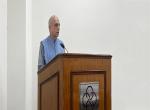
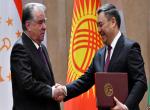



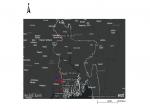
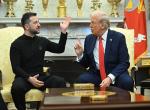
Post new comment